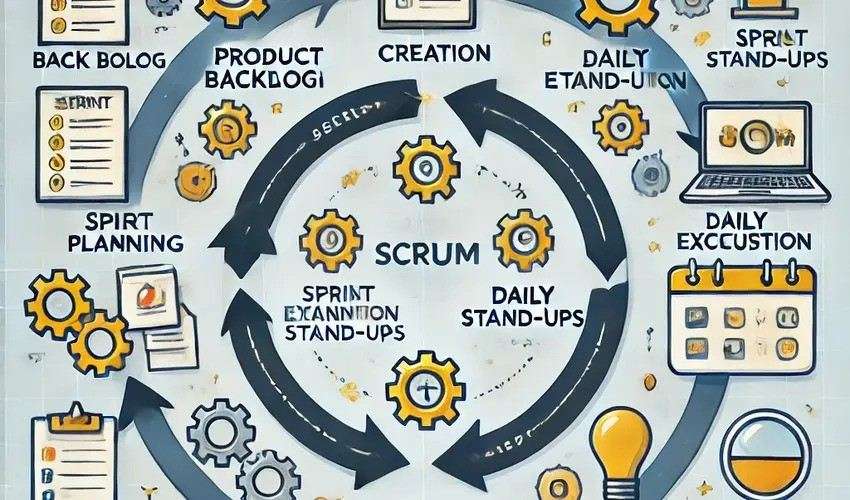Scrum is part of the Agile method. It is known for boosting collaboration, flexibility, and product quality. Scrum breaks projects into sprints. It focuses on iterative development. This helps teams navigate the complexities of software. This article explores the main parts, jobs, and best practices of the Scrum SDLC. It will guide you toward Agile success.
Understanding the Scrum Software Development Life Cycle
Scrum is an Agile framework emphasizing iterative progress, collaboration, and adaptability. It is designed to manage complex projects by breaking them into smaller, more manageable pieces. The Scrum SDLC comprises several phases, each contributing to the project’s overall success.
Key Phases of the Scrum Software Development Life Cycle
- Product Backlog Creation The product backlog is the foundation of the Scrum SDLC. It is a prioritized list of all features, enhancements, bug fixes, and tasks needed for the project. The product owner maintains the backlog and ensures it reflects the needs and priorities of the stakeholders.
- Sprint planning marks the start of each sprint. Sprints last two to four weeks. During this phase, the team picks items from the product backlog. They pick the ones to include in the sprint backlog. They set a sprint goal and outline the tasks necessary, ensuring the workload is realistic and manageable.
- In the sprint execution phase, the team works on the tasks in the sprint backlog. The meetings are called daily stand-ups or daily Scrums. They discuss progress, address obstacles, and plan the day’s activities. This phase emphasizes continuous collaboration and communication among team members.
- At the end of the sprint, the team has a sprint review. They showcase the completed work to stakeholders. Feedback is collected and used to refine the product backlog. The sprint review ensures that the product evolves as stakeholders expect. It also lets us make adjustments.
- After the sprint review, the team holds a sprint retrospective. They meet to reflect on the sprint. They discuss what went well, what could be improved, and how to implement changes in future sprints. The retrospective fosters a culture of continuous improvement.
- Release planning is ongoing. It determines when new software will be available to customers. The product owner considers progress made during sprints, market demands, and stakeholder requirements to decide when and how much to release.
Key Roles in Scrum
- The product owner is the voice of the stakeholders. They create and rank the product backlog, bridge the team and the stakeholders, and ensure the team focuses on high-value tasks.
- Scrum Master, The Scrum master is a facilitator who ensures the team follows Scrum practices and principles. They help remove obstacles, foster collaboration, and promote continuous improvement. The Scrum master also ensures that meetings are productive and focused.
- The team is a group of professionals. They have the diverse skills needed to complete the tasks in the sprint backlog. They are self-organizing and cross-functional, collectively responsible for delivering the sprint goal.
Best Practices for Navigating the Scrum Software Development Life Cycle
- Commit to Continuous Improvement Continuous improvement is at the heart of Scrum. Teams should regularly review their processes and identify areas for enhancement. The sprint retrospective is very useful. It helps create a culture of ongoing improvement.
- Prioritize Effective Communication Clear and consistent communication is vital for Scrum’s success. Regular meetings, like daily stand-ups and sprint reviews, keep things clear. They ensure everyone is aligned with the project goals.
- Maintain a clear and detailed product backlog. It must be prioritized. The product owner must work closely with stakeholders. They must do so to ensure the backlog items fit the project’s vision and goals.
- Embrace Flexibility One of Scrum’s strengths is its adaptability. Teams should be ready to change their plans. They should do this based on feedback and new requirements. Embracing flexibility allows teams to respond to new information and deliver better outcomes.
- Foster a Collaborative Environment Collaboration is crucial for Scrum’s success. Team members should be encouraged to work together, share knowledge, and support each other. A collaborative environment enhances creativity and problem-solving.
Overcoming Challenges in Scrum Implementation
Implementing Scrum is not without its challenges. Common issues include resisting change, unclear roles and responsibilities, and hard-to-keep-consistent communication. To beat these challenges, organizations should train their teams well. They should also give them support and resources. Also, if leaders commit to embracing Agile, it can greatly ease the transition.
Benefits of the Scrum Software Development Life Cycle
The Scrum SDLC offers numerous benefits, including:
- Scrum increases flexibility. Its iterative approach lets teams adapt to changing needs and feedback.
- Improved Collaboration: Regular meetings and clear roles foster better communication and teamwork.
- Higher-quality products result from continuous testing and feedback. They ensure the product changes according to stakeholder needs.
- Increased Transparency: The Scrum framework promotes visibility into the project’s progress and challenges.
Conclusion
Nailing the Scrum cycle needs a commitment to Agile principles. It also needs good communication and a love of change. Teams can improve. They can do this by understanding and using the key phases and roles of Scrum. This will help their productivity, collaboration, and product quality. They should also follow its best practices. It doesn’t matter if you’re new to Scrum. Or if you’re looking to improve your processes. This framework offers a strong path to Agile success. Embrace the iterative journey. Prioritize continuous improvement. Then, watch your projects thrive in the dynamic world of software development.
Zainab Afzal is a senior SEO Consultant and Writer. She has 5+ years of experience in Digital Marketing. After completing his degree in BS computer science, she has worked with different IT companies.



